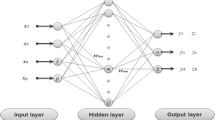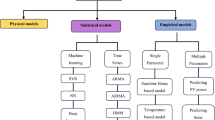Abstract
Regional analyses in solar energy applications take a long time, and the complexity of production modeling of solar panels is a problem for small roof applications. This is because the people who will implement these applications do not have sufficient budgets to establish pyrometers and similar expensive measurement systems, or they do not have enough technical information to analyze them. However, other meteorological data, such as wind, temperature, and humidity, have been recorded for a long time by various institutions around the world, and these data can be accessed. Within the scope of this article, an artificial neural network-based model has been developed, which requires cheaper and less information for the users who will implement the roof-top application. In an area where temperature, wind speed, pressure, and humidity information is given, using the developed neural network learning model, the output power of the most commonly used mono-crystalline, poly-crystalline, and thin-film solar panels was calculated. In order to be used in the modeling of the study, the production values of the three different panels and wind, temperature, and humidity measurements of the region where the panels were installed were recorded in periods of 1 min. The relationship between these data was modeled by artificial neural networks. To increase the reliability of the data, training and test data were used, obtained as a result of the tenfold cross-validation method. Using the developed model, production values were estimated to have 97% accuracy. As a result, a simpler and more reliable analysis model has been developed without the use of radiation and panel information, without the need for PV and system modeling, which requires long mathematical processes.









Similar content being viewed by others
References
Conti J, Holtberg P, Diefenderfer J, LaRose A, Turnure JT, Westfall L (2016) International energy outlook 2016 with projections to 2040. Technical report, USDOE Energy Information Administration (EIA), Washington, DC (United States)
Kabir E, Kumar P, Kumar S, Adelodun AA, Kim KH (2018) Solar energy: potential and future prospects. Renew Sustain Energy Rev 82:894. https://doi.org/10.1016/j.rser.2017.09.094
Pillot B, Muselli M, Poggi P, Dias JB (2019) Historical trends in global energy policy and renewable power system issues in Sub-Saharan Africa: the case of solar PV. Energy Policy 127:113
Adib R, Murdock H, Appavou F, Brown A, Epp B, Leidreiter A, Lins C, Murdock H, Musolino E, Petrichenko K (2015) Renewables 2015 global status report, REN21 Secretariat, Paris
García JL, Jurado F, Larco V (2019) Review and resource assessment, solar energy in different region in Ecuador. E3S Web Conf 80:01003. https://doi.org/10.1051/e3sconf/20198001003
Li HZ, Kopsakangas-Savolainen M, Yan MZ, Wang JL, Xie BC (2019) Which provincial administrative regions in China should reduce their coal consumption? An environmental energy input requirement function based analysis. Energy Policy 127:51. https://doi.org/10.1016/j.enpol.2018.11.037
Ventre G, Farhi B, Szaro J, Dunlop J, Dunlop JP, Farhi BN, Post HN, Szaro JS, Ventre GG (2001) Reducing the costs of grid-connected photovoltaic systems proceedings of solar forum 2001: paper reducing the costs of grid-connected photovoltaic systems. In: Proceedings of Solar Forum (321)
Schäfer M, Kebir N, Neumann K (2011) Research needs for meeting the challenge of decentralized energy supply in developing countries. Energy Sustain Dev 15(3):324. https://doi.org/10.1016/j.esd.2011.07.001
Ministry of Energy and Natural Resources, Solar Energy (2019). https://www.enerji.gov.tr/en-US/Pages/Solar
Haci S, Ismail B, Serkan C (2018) Turkey’s energy strategy for 2023 targets after 2000 MW giant renewable energy contract. E3S Web Conf 64:01001. https://doi.org/10.1051/e3sconf/20186401001
Durusu A, Erduman A (2018) An Improved Methodology to Design Large-Scale Photovoltaic Power Plant. J Solar Energy Eng Trans ASME 10(1115/1):4038589
Green MA, Emery K, Hishikawa Y, Warta W, Dunlop ED (2016) Solar cell efficiency tables (version 47). Prog Photovol Res Appl 24(1):3. https://doi.org/10.1002/pip.2728
Costa SC, Diniz ASA, Kazmerski LL (2016) Dust and soiling issues and impacts relating to solar energy systems: Literature review update for 2012–2015. Renew Sustain Energy Rev 63:33. https://doi.org/10.1016/j.rser.2016.04.059
Kaldellis JK, Kapsali M (2011) Simulating the dust effect on the energy performance of photovoltaic generators based on experimental measurements. Energy 36(8):5154. https://doi.org/10.1016/j.energy.2011.06.018
Maghami MR, Hizam H, Gomes C, Radzi MA, Rezadad MI, Hajighorbani S (2016) Power loss due to soiling on solar panel: a review. Renew Sustain Energy Rev 59:1307. https://doi.org/10.1016/j.rser.2016.01.044
Romero-Fiances I, Muñoz-Cerón E, Espinoza-Paredes R, Nofuentes G, De La Casa J (2019) Analysis of the performance of various pv module technologies in Peru. Energies 12:1. https://doi.org/10.3390/en12010186
Akdemir H, Durusu A, Erduman A, Nakir I (2018) Effect of energy management of a grid connected photovoltaic/ battery/load system on the optimal photovoltaic placement on a national scale: The case of Turkey. J Solar Energy Eng Trans ASME 10(1115/1):4039077
Ayaz R, Durusu A, Akca H (2017) Determination of Optimum tilt angle for different photovoltaic technologies considering ambient conditions: a case study for Burdur, Turkey. J Solar Energy Eng 139(4):041001. https://doi.org/10.1115/1.4036412
Celik AN (2011) Artificial neural network modelling and experimental verification of the operating current of mono-crystalline photovoltaic modules. Solar Energy 85(10):2507. https://doi.org/10.1016/j.solener.2011.07.009
Manzano A, Martín ML, Valero F, Armenta C (2015) A single method to estimate the daily global solar radiation from monthly data. Atmos Res 166:70. https://doi.org/10.1016/j.atmosres.2015.06.017
Celik AN, Muneer T (2013) Neural network based method for conversion of solar radiation data. Energy Convers Manag 67:117. https://doi.org/10.1016/j.enconman.2012.11.010
Bayrakç HC, Demircan C, Keçeba A (2018) The development of empirical models for estimating global solar radiation on horizontal surface: a case study. Renew Sustain Energy Rev 81:2771. https://doi.org/10.1016/j.rser.2017.06.082
Bakirci K, Kirtiloglu Y (2018) Prediction of diffuse solar radiation using satellite data. Int J Green Energy 15(2):76. https://doi.org/10.1080/15435075.2018.1423976
De Rossi F, Pontecorvo T, Brown TM (2015) Characterization of photovoltaic devices for indoor light harvesting and customization of flexible dye solar cells to deliver superior efficiency under artificial lighting. Appl Energy 156:413
Çelik Ö, Teke A, Yildirim HB (2016) The optimized artificial neural network model with Levenberg–Marquardt algorithm for global solar radiation estimation in Eastern Mediterranean Region of Turkey. J Clean Prod 116:1. https://doi.org/10.1016/j.jclepro.2015.12.082
Yücelbaş Ş, Özşen S, Yücelbaş C, Tezel G, Küççüktürk S, Yosunkaya Ş (2016) Effect of EEG time domain features on the classification of sleep stages. Indian J Sci Technol 9:1–8
Hontoria L, Aguilera J, Zufiria P (2002) Generation of hourly irradiation synthetic series using the neural network multilayer perceptron. Solar Energy 72(5):441. https://doi.org/10.1016/S0038-092X(02)00010-5
Yücelbaş Ş, Yücelbaş C, Tezel G, Özşen S, Küççüktürk S, Yosunkaya Ş (2017) Pre-determination of OSA degree using morphological features of the ECG signal. Expert Syst Appl 81:79
Yücelbaş Ş, Yücelbaş C, Tezel G, Özşen S, Yosunkaya Ş (2018) Automatic sleep staging based on SVD, VMD, HHT and morphological features of single-lead ECG signal. Expert Syst Appl 102:193
Bengio Y, Grandvalet Y (2004) No unbiased estimator of the variance of K-fold cross-validation. J Mach Learn Res 5:1089
Acknowledgements
This study was supported by the Scientific Research Support Unit of the Hakkari University under Grant FM2017BAP4.
Author information
Authors and Affiliations
Corresponding author
Ethics declarations
Conflict of interest
The author declares that he has no conflict of interest.
Additional information
Publisher's Note
Springer Nature remains neutral with regard to jurisdictional claims in published maps and institutional affiliations.
Rights and permissions
About this article
Cite this article
Erduman, A. A smart short-term solar power output prediction by artificial neural network. Electr Eng 102, 1441–1449 (2020). https://doi.org/10.1007/s00202-020-00971-2
Received:
Accepted:
Published:
Issue Date:
DOI: https://doi.org/10.1007/s00202-020-00971-2




